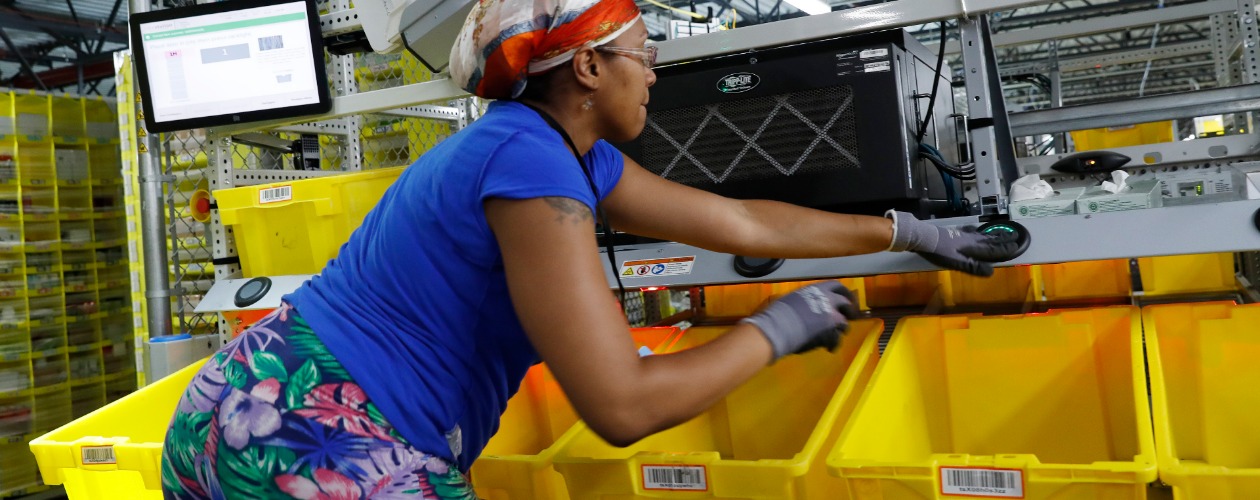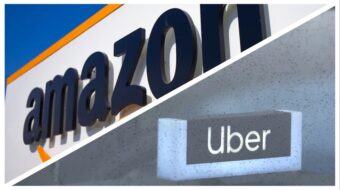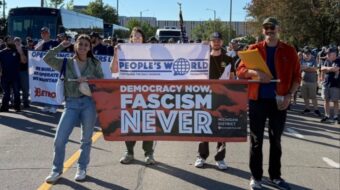
STATEN ISLAND, N.Y.—What’s it like toiling inside a big Amazon warehouse, which the corporate behemoth euphemistically calls “a fulfillment center”?
In a word, say two workers inside the largest of the firm’s four warehouses on Staten Island, N.Y., it’s awful. And those conditions boost the union organizing drive at the facility, JFK8.
In telephone interviews with People’s World, Justine Medina and Brett Daniels, members of Amazon Labor Union’s organizing committee there, described backbreaking work, lack of information about the coronavirus, 60-hour-plus workweeks, 20% of colleagues out with the virus, 10-hour shifts with “mandatory overtime” tacked on, and two- and three-hour commutes.

Then there are the speedups. Amazon keeps forcing its line to speed faster and faster. “They’re so fast, you can’t really take safety into account,” Medina notes. Sensors on assembly lines supposedly regulate the speed of goods dashing by, at 700 items per hour.
“Amazon covers them up,” Medina says of the sensors.
All this for pay just above New York City’s $15 hourly minimum wage and few benefits. “Union members make roughly $11,000 more per year than non-union members,” the union’s website says.
“They don’t care” about the workers, says Daniels. “It’s profits over people.”
No wonder the Amazon Labor Union, an independent from-the-ground-up union, begun by Chris Smalls, is gaining steam. Amazon illegally fired Smalls in 2020 for leading a lunchtime walkout over lack of coronavirus protection. Smalls is suing Amazon in federal court, and New York State Attorney General Letitia “Tish” James is probing if his firing broke state laws, too.
Amazon, of course, is fighting the union tooth and nail. Jeff Bezos, one of the three richest people in the U.S., controls the retail monster and distributor. He’s so rich he pumped millions of dollars into hiring union-busters and breaking labor law to successfully stop the Retail, Wholesale and Department Store Union (RWDSU) from organizing workers at Amazon’s warehouse in Bessemer, Ala., in 2021.
RWDSU’s campaign drew national attention, including an open strong endorsement from pro-union Democratic President Joe Biden. Amazon’s lawbreaking then skewed that vote, the National Labor Relations Board said. It threw out RWDSU’s election loss and ordered a rerun, expected in weeks.
Like the Bessemer workers, workers at JFK8 are among the nation’s most-exploited, especially in race and class. “People commute. They’re predominantly working class” and can’t afford to live on Staten Island, New York City’s most-suburban-like borough, says Medina. Most are Black and brown, too.
Thus long commutes or workers doubling up. Harlem resident Medina often camps out at a friend’s Staten Island apartment, rather than commute, sleep a few hours, then turn around and commute another two to three hours back to JFK8.
As happens often in organizing drives, Amazon bosses’ violations, inaction or worse, such as on-the-job injuries, provide unions with some of their best evidence and arguments for workers to vote “yes.”

“I myself haven’t gotten injured yet” on the job, Medina says. “But I worry about hearing loss.” There’s high-decibel noise from loud machinery, robots carrying goods on shelves, conveyor belts, forklift-like trucks, “and alarms are constantly going off.” The robots weigh 400 pounds when empty, and don’t have sensors to tell them if a person is just ahead of them in the warehouse aisles.
Workers “are supposed to use sticks” to clear conveyor belt jams. There are 5-minute safety training films. The use of sticks potentially violates federal Occupational Safety and Health Administration regulations, other cases show. “It’s very easy to lose an arm,” Medina says.
At least “I haven’t had a knife fall on me,” out of a bin of goods placed on shelves far above the worker’s head, Medina admits. That happened to a colleague. That’s not all.
“I’ve met so many people who have told me about broken bones on the job, but they have to continue to work. They don’t have unpaid leave time to take, and Amazon clocks” their time on the job, minute by minute, and docks those who stay away too long. “People had to go out on workers’ comp,” Medina adds. Many don’t go to the doctor, fearing company retribution.
Ergonomic (repetitive motion) injuries abound, Medina reports. “A lot of young people, in their 20s, are taking pain medication every day because their backs and muscles are already overexerted.”
Then there’s the virus. “It’s absolutely horrifying,” Daniels says of the company’s response. In just one example, Daniels’s roommate, who also works at JFK8, came down with the coronavirus. Both had to quarantine. “We gave up two weeks work and we didn’t get paid.”
That’s a change from before, Medina notes. At the start of the pandemic, the firm followed federal law and gave workers who tested positive the mandatory 14 days off with pay to recover. When the federal Centers for Disease Control said sick workers had to quarantine for only 10 days, Amazon shifted to that figure, at 60% pay. Late last year, CDC cut the quarantine time to five days. Amazon followed suit. With no pay.
“Now the policy is excused unpaid leave for up to five days,” Medina explains. But coronavirus test results take longer to be returned in the mail, thanks to Trump regime Postmaster General Louis DeJoy’s service slowdowns, though Medina didn’t say so. And the workers must stay out till results come in.
“’Here’s my test. It took a week,’” workers tell Amazon human resources reps. “Our policy is five days,” they reply. So workers have to take the extra two days “from unpaid time off. And there used to be onsite testing. Now you have to go home, then wait in line for three hours. People are begging ‘Bring onsite testing back,’” Medina reports.
Meanwhile, “people are incentivized to go in” to work, even if they’re sick.
Amazon doesn’t help protect workers, their families, or the community against the virus, either. Medina says it occasionally reveals “workers tested positive,” but it doesn’t say in which departments, so co-workers don’t know if they’re exposed, too. The union has found out some of those details.
“They also removed the barriers” between workers, thus lessening physical distancing, Daniels adds. That raises the risk of catching the virus, especially its new and easily spreading Omicron variant. The lack of information caught AG James’ attention, as well.
James’ suit also says Amazon “didn’t do enough cleaning and disinfection, didn’t notify workers who had been in contact with infected colleagues, and maintained productivity policies that didn’t give workers have enough time for hygiene and social distancing.”
“That’s the danger aspect,” Medina adds. “A lot of people have families and kids to keep in contact with” and are concerned about unwitting transmission of the virus. And in Bessemer, Daniels says, Amazon lied about the virus’s impact. The JFK8 workers know about that, too.
“They had two deaths there within 24 hours. One was in the back of a truck, without a witness. The other was in the hospital. Both didn’t feel well” beforehand, but both “didn’t have enough hours” available to take time off. They were sick at work.
Then there’s the Staten Island overtime. In the runup to the December holidays, mandatory overtime was common after 10-hour shifts, both say. Daniels says shifts actually lasted 12 hours at a minimum. JFK8 workers expected the pace to slacken after New Year’s Day. No such luck, Medina says.
The shifts are still 10 hours, the OT is still mandatory. Transportation to and from JFK8, especially when a shift ends at, say, 6:15 am, is both long and erratic. So dedicated shuttle buses to the closest 24-7 transit, the Staten Island Ferry, is one union and worker demand. Medina estimates the shuttle would cut workers’ commutes by half an hour each way.
Amazon warehouse workers in the Chicago neighborhood of Gage Park and the suburb of Cicero, who are organizing there, have a similar demand. With a lack of mass transit, especially after middle-of-the-night shifts, they want Amazon to pay for transportation home.
“The work is so isolated,” adds Medina. “You’re by yourself for 10 hours a day counting objects” or transferring them from floor to floor in the giant warehouse. All this exploitation, combined, ricocheted against Amazon’s anti-union case, the two workers say.
“More and more people are feeling committed to sign up” after the union, on its own, dug out and publicized details about coronavirus outbreaks at JFK8, says Daniels. The union-busting meetings Amazon hosts, pulling workers off the job to harangue them, irk the workers instead. “They think it’s more valuable to waste our time,” Daniels says of factory bosses.
Union-busting at a cost of tens of thousands of dollars so far is not all Bezos and his team are doing to try to stop the union there, the two add.

As it did in Bessemer, Amazon “is trying to expand the bargaining unit” beyond the workers the union wants to organize in JFK8, Medina says. That’s a common employer tactic in organizing drives. When the National Labor Relations Board says “yes,” and bosses win such expansions, they stuff the voting rolls with known union foes.
Like other labor law-breakers, Amazon also deliberately disciplines, demotes, and fires pro-union workers at JFK8, Medina adds. That’s what it did to Smalls. And Amazon changes the shifts of union advocates among the 5,000 workers with little notice. The union responded with a line of complaints to the NLRB regional office in Brooklyn, which covers Staten Island.
The workers notice, and realize the union is standing up for them. In the meantime, the organizing committee, which has grown beyond its original 15 members, is collecting more and more union election authorization cards.
And despite Amazon’s fearsome reputation, its overwhelming riches, and its rampant labor law-breaking, Medina, Daniels and their union organizing colleagues are standing up and speaking out.
“We lean into being very loud and open,” says Medina. “We say to them, ‘OK, you’re going to fire me? That’s illegal and I’m going to sue you.
“That’s the kind of energy we need.”










